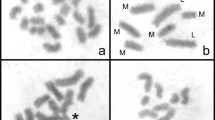Abstract
Light and electronmicroscope studies indicate that Eusimulium aureum (n=2 metacentrics) is male-achiasmate. Supporting evidence for achiasmate meiosis includes lack of recombination between, I) widely separated differential segments of X and Y chromosomes and 2) linked autosomal inversions. In sibling C, chromosome II exists in an alternate “neoacrocentric” form interpreted as originating through the three-break shift of a small segment including centromere and nucleolar organizer. Male-achiasmate meiosis appears to be a prerequisite for the establishment of rearrangements that include large displacements of the centromere. This suggestion is supported by a correlation between achiasmate male meiosis and the fixation of gross pericentric changes in a number of other black fly species.
Similar content being viewed by others
References
Basrur, P. K.: The salivary gland chromosomes of seven segregates of Prosimulium (Diptera: Simuliidae) with a transformed centromere. Canad. J. Zool. 37, 527–570 (1959)
Basrur, P. K.: The salivary gland chromosomes of seven species of Prosimulium (Diptera: Simuliidae) from Alaska and British Columbia. Canad. J. Zool. 40, 1019–1033 (1962)
Brandham, P. E.: Chromosome behaviour in the Aloineae. I. The nature of E type bridge Chromosoma (Berl.) 27, 201–215 (1969)
Carson, H. L.: The selective elimination of inversion dicentric chromatides during meiosis in the eggs of Sciara impatiens. Genetics 31, 95–113 (1946)
Dunbar, R. W.: The salivary gland chromosomes of two sibling species of black flies included in Eusimulium aureum Fries. Canad. J. Zool. 36, 23–44 (1958)
Dunbar, R. W.: The salivary gland chromosome of seven forms of black flies included in Eusimulium aureum Fries. Canad. J. Zool. 37, 495–525 (1959)
Dunbar, R. W.: Chromosome inversions as blocks to genetic exchange, leading to sympatric speciation in black flies (Simuliidae, Diptera). Proc. XIIth. Int. Congr. Entomol. London, 268–269 (1965)
Jackson, R. C.: The karyotype in systematics. Ann. Rev. Ecol. Syst. 2, 327–368 (1971)
Jackson, R. C.: Chromosomal evolution in Haplopappus gracilis: a centric transposition race Evolution (Lawrence, Kans.) 27, 243–256 (1973)
John, B., Hewitt, G. M.: Patterns and pathways of chromosome evolution within the Orthoptera. Chromosoma (Berl.) 25, 40–74 (1968)
King, R. C., Akai, H.: Spermatogenesis in Bombyx mori. II. The ultrastructure of synapsed bivalents. J. Morph. 134, 181–194 (1971)
Landau, R.: Four forms of Simulium tuberosum (Lundstr.) in Southern Ontario: a salivary gland study. Canad. J. Zool. 40, 921–39 (1962)
Levitan, M.: Studies of linkage in populations. VII. Temporal variation and X-chromosomal linkage disequilibriums. Evolution (Lawrence, Kans.) 27, 467–485 (1973)
Noda, S.: Achiasmate bivalent formation by parallel pairing in PMC's of Fritillaria amabilis. Bot. Mag. (Tokyo) 81, 344–345 (1968)
Ottonen, P. O.: Salivary gland chromosomes of six species in the III. S-I, group of Prosimulium Roub. (Diptera: Simuliidae) Canad. J. Zool. 44, 677–701 (1966)
Rothfels, K. H.: Chromosome complement, polyploidy and supernumeraries in Neopodis mopsis abdominalis (Acrididae). J. Morp. 87, 287–316 (1950)
Rothfels, K. H.: Black flies: siblings, sex and species grouping. J. Hered. 47, 113–122 (1956)
Rothfels, K. H., Freeman, M.: The salivary gland chromosomes of three North American species of Twinnia (Diptera: Simuliidae). Cand. J. Zool. 44, 937–945 (1966)
Sturtevant, A. G., Beadle, G. W.: The relations of inversions in the X-chromosome of Drosophila melanogaster to crossing-over and disjunction. Genetics 21, 554–604 (1936)
White, M. J. D.: Animal Cytology and evolution, ed. 3d edit. London: Cambridge University Press 1973`
Author information
Authors and Affiliations
Rights and permissions
About this article
Cite this article
Rothfels, K.H., Mason, G.F. Achiasmate meiosis and centromere shift in Eusimulium aureum (Diptera-Simuliidae). Chromosoma 51, 111–124 (1975). https://doi.org/10.1007/BF00319829
Received:
Accepted:
Issue Date:
DOI: https://doi.org/10.1007/BF00319829




